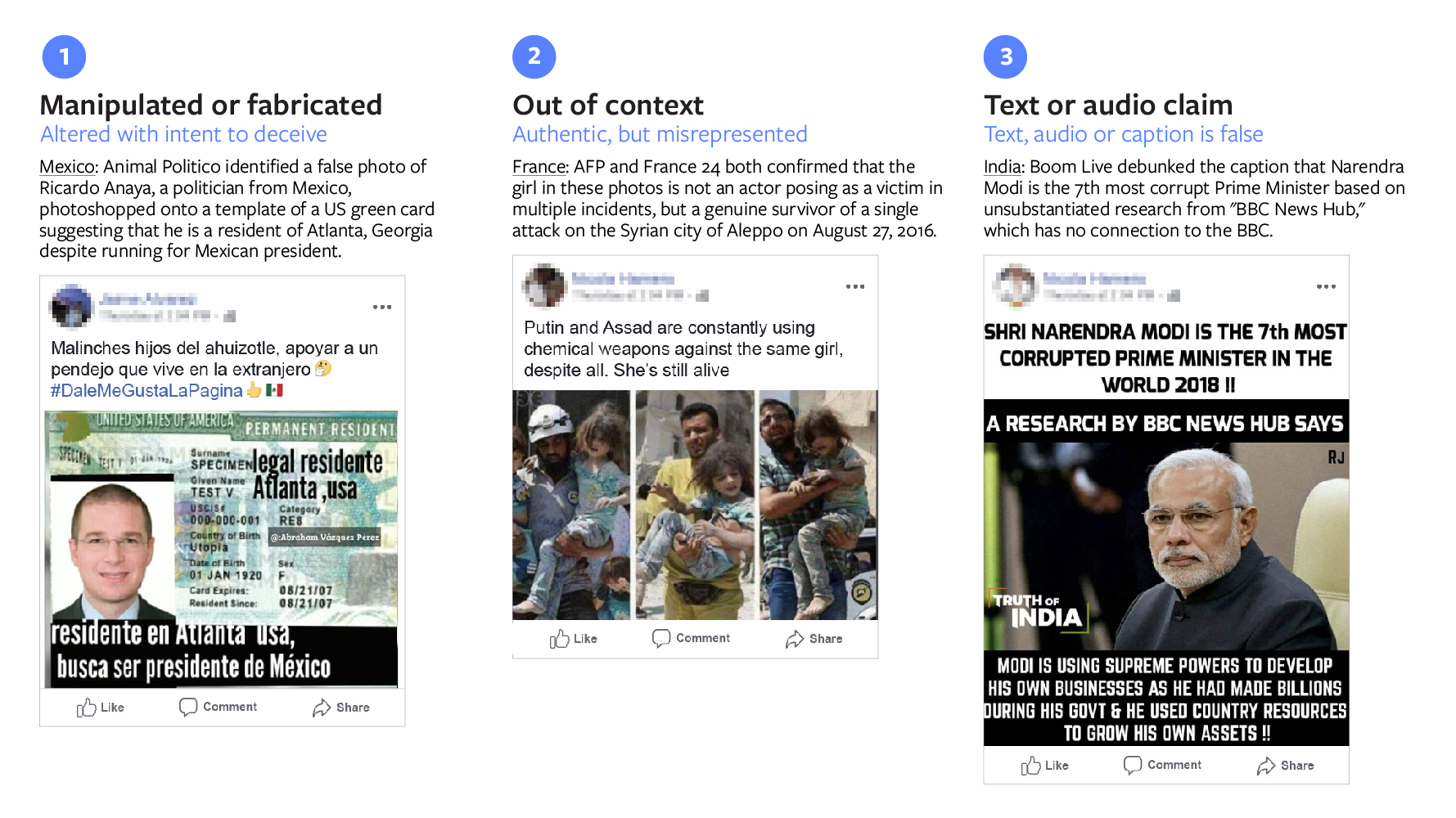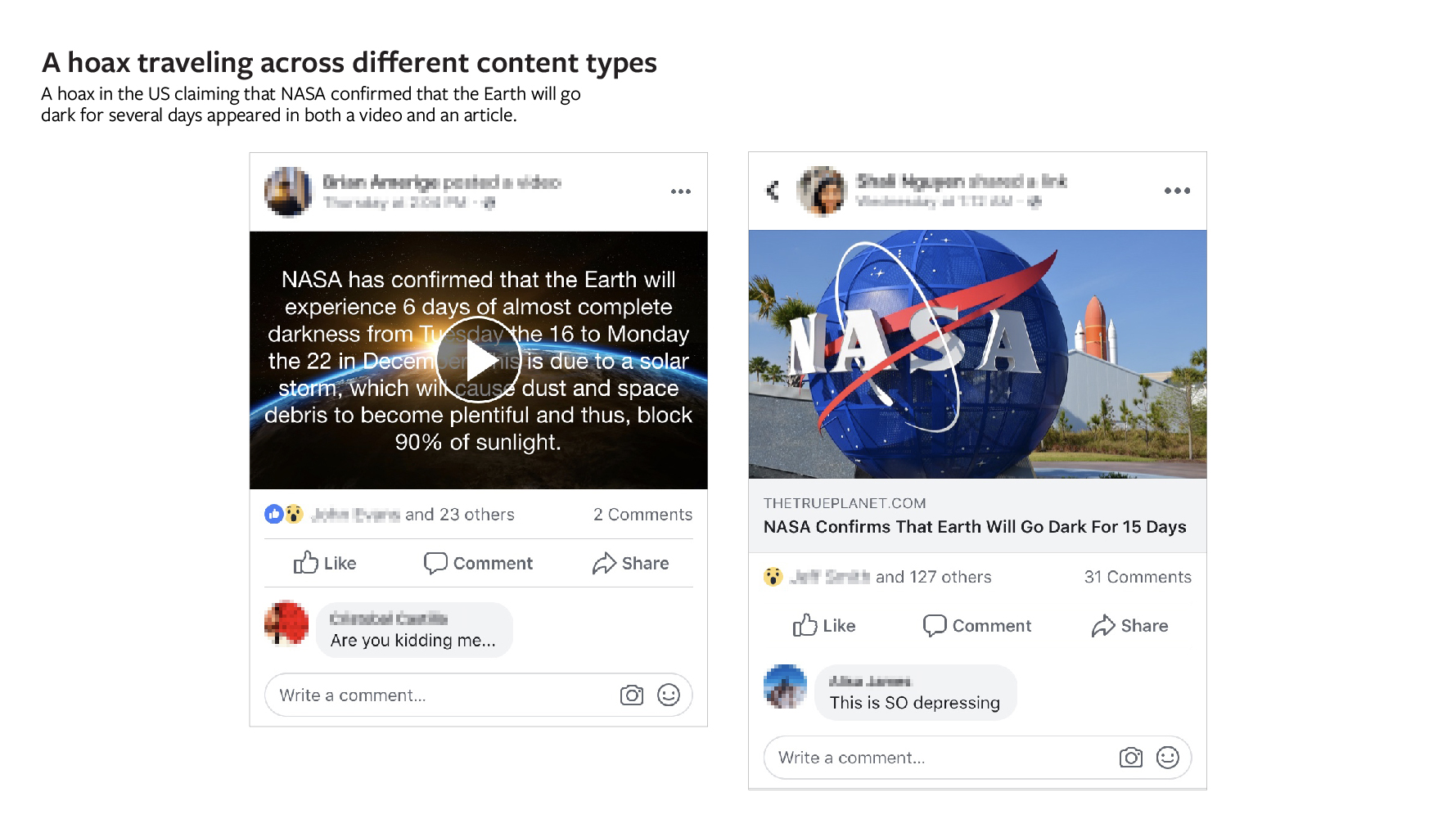Fake images and videos are the next targets of Facebook’s ongoing effort to fight misinformation.
In a blog post published today, the company announced that it is giving all 27 of its global fact-checking partners the ability to debunk photos and videos on the platform. Once a piece of content is rated as false, its future reach in the News Feed will be reduced by up to 80 percent and a fact check will be appended in the Related Articles section. (Disclosure: Being a signatory of the International Fact-Checking Network’s code of principles is a necessary condition to be a partner.)
Videos and photos that users flag as potentially false will now filter into the dashboard that fact-checkers use to select which pieces of content to debunk. Before, most fact-checking partners could only debunk links to false news stories; Agence France-Presse was the first organization to start debunking images for Facebook last spring, when Facebook started testing the capability.
“Many of our third-party fact-checking partners have expertise evaluating photos and videos and are trained in visual verification techniques,” Antonia Woodford, a Facebook product manager, wrote in today’s blog post. “Fact-checkers are able to assess the truth or falsity of a photo or video by combining these skills with other journalistic practices, like using research from experts.”
Stories can have ratings such as false, satire, opinion and prank in Facebook’s system for fact-checking articles, and multimedia will have the same scale. Facebook identified three main categories of false photos and videos that usually make the rounds on the platform: manipulated or fabricated, out of context and text or audio claim.

As Facebook gets more signals from fact-checkers, it will improve its machine learning models’ ability to predict future misinformation. The company is also leveraging technology that can extract text from photos and compare them against headlines in previously debunked stories, according to the blog post.
That’s important because misinformation often travels across media.
“Based on research with people around the world, we know that false news spreads in many different forms, varying from country to country,” Woodford wrote. “However, these categories are not distinct. The same hoax can travel across different content types, so it's important to build defenses against misinformation across articles, as well as photos and videos.”

Thursday’s move comes after months of prodding from fact-checkers and misinformation beat reporters, who noted that only allowing them to fact-check text limited the scope of their fight against misinformation. False memes regularly go viral on Facebook and some infamous, misinforming pages even pivoted to images in favor of stories to avoid getting downranked by fact-checkers.
To Aaron Sharockman, executive director of (Poynter-owned) PolitiFact — one of Facebook’s fact-checking partners — the ability to debunk images and videos is welcome news.
“Anyone who uses Facebook knows that images and videos are a prominent source of misinformation,” he said in a message. “To have a healthier, more honest internet, we need to be scrutinizing images and video just as much as we scrutinize written words.”
Tai Nalon, director of fact-checking organization Aos Fatos — which started debunking images and videos in mid-August — said the additional capability has improved their coverage of the upcoming Brazilian election, which has been marred by misinformation.
“Based on our experience in Brazil, almost half of the misinformation and low-quality content we see in Facebook is accompanied with images,” she said in a message to Poynter. “It means that many things on Facebook are native Facebook content, not only fake or low-quality content websites.”
After presidential candidate Jair Bolsonaro was stabbed last week, much of the content that Aos Fatos analyzed were manipulated photos. Some were poorly altered, but Nalon said they still reached thousands of people relatively quickly — which made fact-checking them even more important.
Facebook’s decision to include multimedia in the fact-checking project comes more than a year and a half after the company first announced the product. It started out solely allowing partner organizations to debunk links because those were what American experts told the company were the most prominent form of misinformation, said Tessa Lyons, a product manager, in a Facebook Q&A published today.
RELATED ARTICLE: Fact-checkers have debunked this fake news site 80 times. It's still publishing on Facebook.
“So we focused on articles to go after and disrupt those financial incentives, and to respond to what we were hearing from people,” she said. “But we know from our research in countries around the world — and in the U.S. — that misinformation isn't limited to articles.”
Over the past few months, Facebook has gone from one alpha partner debunking photo and videos to nine, Lyons and Woodford told Poynter in an email.
“(We) learned a lot along the way about how photo and video misinformation manifests,” they said. It also helped Facebook’s system train machine learning models to predict a potentially false image or video. “At this point we feel we have a good enough understanding of the ecosystem at this point to make this available to all third-party fact-checking partners.”
Chequeado, a fact-checking project based in Argentina, has been one of those alpha partners since the end of July. Executive Director Laura Zommer told Poynter that it’s helped her team and she expects other fact-checkers will reap similar benefits.
“We were worried about it when we started because the dashboard is not necessarily working in a perfect way, especially in languages like Spanish, where there is not so much content (available to fact-check),” she said. “(But) it’s easy — it was not a big transition for the team doing it. And it allowed us to look for more content.”
Guillaume Daudin runs AFP Factuel, which has been debunking images and videos on Facebook since March. He agreed with Zommer, saying having the additional capability has helped his team catch more instances of misinformation that before they’d just have to let go.
“It really increased our ability to fact-check content on Facebook,” he told Poynter in an email. “Before that, it felt like we missed half of Facebook. It still isn’t entirely accurate, but it has a true interest for us. We discovered with that some very powerful false news.”
While it took a while for Facebook to make an improvement that fact-checkers have been asking for months, it’s better late than never, Nalon said — and it could cut down on the amount of misinformation that’s shared on other social media platforms.
“It's always late when we talk about fake news in Brazil, since it's a problem for at least a couple of years,” she said. “However, I think it is relevant because images and videos, they also circulate on WhatsApp. If Facebook alerts people … I think it can have an impact on other social media as well.”
Corrections: A previous version of this article stated that photos and videos will have a different rating scale than links on Facebook. In fact, they will share the same rating scale. Additionally, a previous version of this article stated that false images went viral on Facebook ahead of the Brazilian election because Aos Fatos couldn't debunk them. In fact, they did debunk them since it was an alpha partner.







